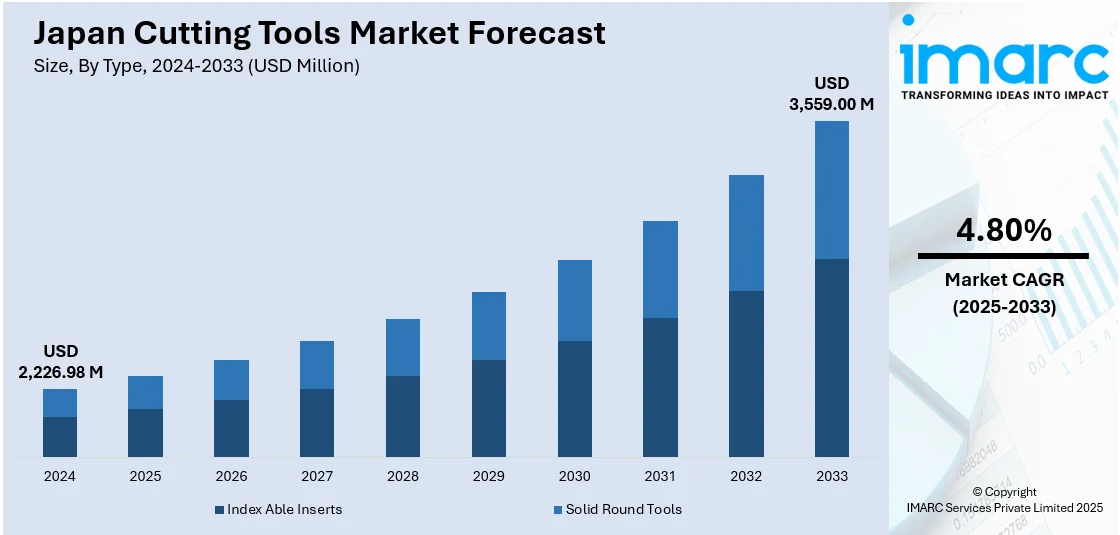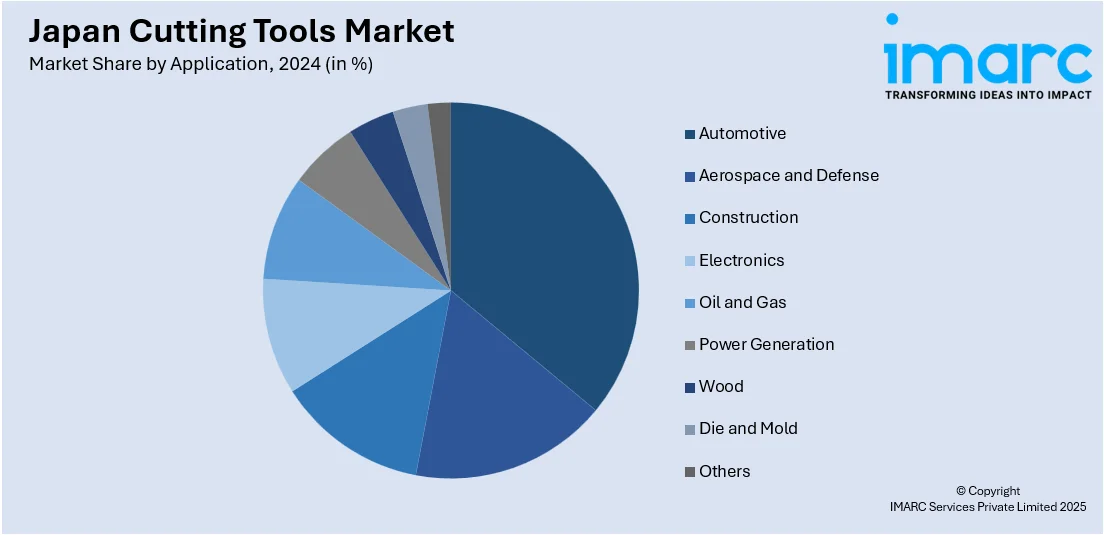
Japan Cutting Tools Market Size, Share, Trends and Forecast by Type, Material Type, Application, and Region, 2025-2033
Japan Cutting Tools Market Overview:
The Japan cutting tools market size reached USD 2,226.98 Million in 2024. Looking forward, IMARC Group expects the market to reach USD 3,559.00 Million by 2033, exhibiting a growth rate (CAGR) of 4.80% during 2025-2033. The demand for precision engineering in industries like automotive, aerospace, and electronics, and advancements in additive manufacturing and automation are factors propelling the market growth. Apart from this, Industry 4.0 integration, the shift towards sustainable manufacturing, innovations in materials, and growth in the construction and infrastructure sectors are supporting the market growth. Furthermore, the rise of robotics in manufacturing, the adoption of lightweight materials in automotive production, increased research and development (R&D) investments in tool development, reshoring of manufacturing, technological advancements in tool coatings, and the focus on reducing production waste are providing a thrust to the Japan cutting tools market share.
|
Report Attribute
|
Key Statistics
|
|---|---|
|
Base Year
|
2024
|
|
Forecast Years
|
2025-2033
|
|
Historical Years
|
2019-2024
|
| Market Size in 2024 | USD 2,226.98 Million |
| Market Forecast in 2033 | USD 3,559.00 Million |
| Market Growth Rate 2025-2033 | 4.80% |
Japan Cutting Tools Market Trends:
Demand for Precision Engineering across Larger Sectors
Japan's cutting tools market is dominated significantly by the increasing demand for precision engineering in end-use applications such as automotive, aerospace, and electronics. These industries require cutting tools that will deliver high precision, reliability, and quality, which are critical to maintain strict production standards. Precision engineering involves the designing and manufacturing of parts and components with extremely close tolerances, and high-performance cutting tools that can make accurate cuts and surfaces are needed. In the automotive field, for instance, precision is most required in manufacturing engine parts, transmissions, and other high-performance components. The aerospace sector is another key driver, where durability and safety are of prime importance, necessitating cutting tools to deal with materials such as titanium and high-strength alloys. In electronics, where parts are required to fit snugly in small spaces, cutting tools capable of dealing with miniaturized components are highly sought after.

Growth of Advanced Manufacturing Processes
Development of new manufacturing technologies is another major driver of the Japan cutting tools market. Such technologies, such as additive manufacturing (3D printing) and automation, are transforming product design, prototyping, and manufacturing. Additive manufacturing facilitates quick prototyping and production of intricate forms that are difficult or impossible to create using traditional techniques. However, even these processes require high-quality cutting tools to finish and finalize the printed components, thus increasing the need for specialized cutting tools in the Japanese market. Automation is also a driving factor that has generated increasing demand for cutting tools. In Japan, the manufacturing sector has gone through enormous advancements in automation, as robots and automated equipment perform more of the manufacturing process, particularly in manufacturing industries like auto manufacturing. Automated equipment requires cutting tools that can be applied using robotic arms and other machinery in order to produce efficiently and reliably.
Focus on Industry 4.0 and Smart Factories
Japan's focus on Industry 4.0, alternatively known as the Fourth Industrial Revolution, is a primary driver of the cutting tools market. Industry 4.0 refers to the integration of digital technologies into manufacturing, including automation, big data, cloud computing, and the Internet of Things (IoT). In Japan, many manufacturing companies are investing in smart factories featuring advanced technologies that enhance production efficiency and flexibility. These plants rely heavily on cutting tools that are not only precise but also embedded with digital technologies to optimize performance and reduce downtime. The other salient aspect of Industry 4.0 in Japan is the increased use of IoT-linked machinery that collects real-time data to monitor the health and performance of manufacturing equipment. This allows companies to perform predictive maintenance, reducing the likelihood of equipment failure and ensuring around-the-clock production. These cutting tools in these smart factories are typically sensor-equipped, and they can communicate with such systems so that real-time adjustments can be made in order to improve the precision of cutting and improve tool life, thereby driving the Japan cutting tools market growth.
Japan Cutting Tools Market Segmentation:
IMARC Group provides an analysis of the key trends in each segment of the market, along with forecasts at the country and regional levels for 2025-2033. Our report has categorized the market based on type, material type, and application.
Type Insights:
- Index Able Inserts
- Solid Round Tools
The report has provided a detailed breakup and analysis of the market based on the type. This includes index able inserts and solid round tools.
Material Type Insights:
- Cemented Carbide
- High-Speed Steel
- Ceramics
- Stainless Steel
- Polycrystalline Diamond
- Cubic Boron Nitride
- Exotic Materials
A detailed breakup and analysis of the market based on material type have also been provided in the report. This includes cemented carbide, high-speed steel, ceramics, stainless steel, polycrystalline diamond, cubic boron nitride, and exotic materials.
Application Insights:

- Automotive
- Aerospace and Defense
- Construction
- Electronics
- Oil and Gas
- Power Generation
- Wood
- Die and Mold
- Others
The report has provided a detailed breakup and analysis of the market based on the application. This includes automotive, aerospace and defense, construction, electronics, oil and gas, power generation, wood, die and mold, and others.
Regional Insights:
- Kanto Region
- Kansai/Kinki Region
- Central/Chubu Region
- Kyushu-Okinawa Region
- Tohoku Region
- Chugoku Region
- Hokkaido Region
- Shikoku Region
The report has also provided a comprehensive analysis of all the major regional markets, which include Kanto Region, Kansai/Kinki Region, Central/Chubu Region, Kyushu-Okinawa Region, Tohoku Region, Chugoku Region, Hokkaido Region, and Shikoku Region.
Competitive Landscape:
The market research report has also provided a comprehensive analysis of the competitive landscape. Competitive analysis such as market structure, key player positioning, top winning strategies, competitive dashboard, and company evaluation quadrant has been covered in the report. Also, detailed profiles of all major companies have been provided.
Japan Cutting Tools Market News:
- At JIMTOF 2024 in Tokyo, Kennametal introduced 3D-printed stator bore tools for EV manufacturing, along with the KCP25C ISO turning inserts and HARVI™ II TE end mills, enhancing aerospace and e-mobility machining capabilities.
- In 2024, Kyocera released the "KGZ" cut-off tool, designed for precision machining of small components, addressing the growing demand in compact part manufacturing.
Japan Cutting Tools Market Report Coverage:
| Report Features | Details |
|---|---|
| Base Year of the Analysis | 2024 |
| Historical Period | 2019-2024 |
| Forecast Period | 2025-2033 |
| Units | Million USD |
| Scope of the Report |
Exploration of Historical Trends and Market Outlook, Industry Catalysts and Challenges, Segment-Wise Historical and Future Market Assessment:
|
| Types Covered | Index Able Inserts, Solid Round Tools |
| Material Types Covered | Cemented Carbide, High-Speed Steel, Ceramics, Stainless Steel, Polycrystalline Diamond, Cubic Boron Nitride, Exotic Materials |
| Applications Covered | Automotive, Aerospace and Defense, Construction, Electronics, Oil and Gas, Power Generation, Wood, Die and Mold, Others |
| Regions Covered | Kanto Region, Kansai/Kinki Region, Central/Chubu Region, Kyushu-Okinawa Region, Tohoku Region, Chugoku Region, Hokkaido Region, Shikoku Region |
| Customization Scope | 10% Free Customization |
| Post-Sale Analyst Support | 10-12 Weeks |
| Delivery Format | PDF and Excel through Email (We can also provide the editable version of the report in PPT/Word format on special request) |
Key Questions Answered in This Report:
- How has the Japan cutting tools market performed so far and how will it perform in the coming years?
- What is the breakup of the Japan cutting tools market on the basis of type?
- What is the breakup of the Japan cutting tools market on the basis of material type?
- What is the breakup of the Japan cutting tools market on the basis of application?
- What is the breakup of the Japan cutting tools market on the basis of region?
- What are the various stages in the value chain of the Japan cutting tools market?
- What are the key driving factors and challenges in the Japan cutting tools?
- What is the structure of the Japan cutting tools market and who are the key players?
- What is the degree of competition in the Japan cutting tools market?
Key Benefits for Stakeholders:
- IMARC’s industry report offers a comprehensive quantitative analysis of various market segments, historical and current market trends, market forecasts, and dynamics of the Japan cutting tools market from 2019-2033.
- The research report provides the latest information on the market drivers, challenges, and opportunities in the Japan cutting tools market.
- Porter's five forces analysis assist stakeholders in assessing the impact of new entrants, competitive rivalry, supplier power, buyer power, and the threat of substitution. It helps stakeholders to analyze the level of competition within the Japan cutting tools industry and its attractiveness.
- Competitive landscape allows stakeholders to understand their competitive environment and provides an insight into the current positions of key players in the market.
Need more help?
- Speak to our experienced analysts for insights on the current market scenarios.
- Include additional segments and countries to customize the report as per your requirement.
- Gain an unparalleled competitive advantage in your domain by understanding how to utilize the report and positively impacting your operations and revenue.
- For further assistance, please connect with our analysts.
 Request Customization
Request Customization
 Speak to an Analyst
Speak to an Analyst
 Request Brochure
Request Brochure
 Inquire Before Buying
Inquire Before Buying




.webp)




.webp)












